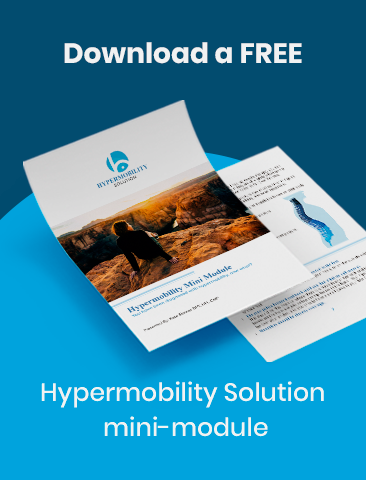Sometimes just understanding your situation doesn’t fix everything by itself, and you need extra help.
This extra help can come from any number of medical or alternative health providers singly or in combination. If you need additional assistance, make sure to find the help you need.
Hypermobility is not understood well by many providers, and you may need to try several before you find a group of people who can support you.
Check out this article for tips on finding the best team to help you along on your hypermobility journey.
Table of contents
- Find a great primary care provider
- Find a great manual therapist
- Find a strength coach
- Focus on the symptom or problem
- Know what your provider can do for you
- Don’t discount a professional
- Ask Questions
- Alternative care
Find a great primary care provider
It can be a family practice, internal medicine, naturopathic, but someone who can keep an eye on your health from the whole picture.
It is someone who can order testing if you need it to rule out other problems that can be associated with hypermobility. They can prescribe and monitor medication that can be helpful to manage pain and inflammatory issues if you need them.
This should be a person who, if they don’t know about hypermobility, is willing to learn and willing to support you in your search with testing, medications, and finding answers.
Next, you need a manual therapist.

Find a great manual therapist
This can be a physical therapist, a massage therapist, an alternative practitioner who does hands-on therapy to help you manage your muscle pain and spasms and correct your alignment.
This does not tend to be a feel-good type of treatment, but a therapeutic one, and not all therapists are equal.
You need to find someone who can look at your alignment and see which tight muscles need to be worked out and which ones need to be left alone.
How do you know if someone can do this? First of all, ask them.
Talk to them about their experience and their approach, and if you can’t find someone who understands hypermobility, find someone willing to learn and work with you and learn what you need.
If you find an all-in-one therapist, that is a great find. If you don’t, you may need to find another provider who can assess and manage your alignment.
Find a strength coach
The last type of provider is a strength coach.
This is loosely used for someone who can work with you on improving your overall strength, both focusing on small muscles, correct muscle use, and stabilization.
You want to wait on activities such as yoga, dance, and ballet until you feel like you have good control first.
The other thing that these people are good for is accountability. Most of us, even with the best of intentions, don’t get nearly as much strengthening as we plan to, or as often.
This person can be a physical therapist, a personal trainer, a pilates instructor, and an exercise physiologist. Still, you need a stabilization strength program and not just a heavy lifting program.
Some providers are covered by insurance where others are not, and your financial situation may impact your choices as well. This is also a choice you get to make.

Focus on the symptom or problem
Often people with these conditions go to the doctor with entire lists of symptoms, pains, problems, and in the current world of short office visits, people can’t get through their history, let alone their problems, and have time for a treatment plan.
If you don’t run into this issue, consider yourself lucky. If you do, work with the system. Don’t fight the current healthcare system while you are trying to get help.
For example, if you want help with your hypermobility, start with setting up an appointment with your doctor, and before you go in, decide what you want.
Do you want to look at a diagnosis? Do you want a referral for therapy? Do you want medication to help you manage the symptoms?
Once you decide which of these you want, stick to your plan.
At your visit, if it is your first visit with a new provider, summarize your situation in 2 sentences,
then follow up with your request or the things you would like from the appointment.
For example, I have been dealing with widespread pain for the last 2 years, and now am struggling to walk. I have been told this may be Ehlers Danlos but have never been officially diagnosed. Who would be able to evaluate me for this? Do you think physical therapy might be helpful? Is there something that could help me with my pain or my muscle spasms?
Allow your physician to make recommendations.
They may know someone who would be right for you to talk to or work with.

Know what your provider can do for you
Do your research. While everyone would love to show up in an office and have the provider tell you everything about your condition and what you should do about it, the reality is there is so much knowledge out there.
Everyone is so specialized that often they don’t always have the answers you are looking for or if what they can offer you is not what you want; then you need to find a different type of provider.
For example, (doctors of osteopathy) DO’s often provide hands-on evaluation and treatment, but this is not typical of an MD (medical doctor).
Many physicians and even specialists will not diagnose hypermobility, so find out if they do before you see them if that is what you are looking for. Many providers will not prescribe pain medications, you can typically find this out before you see them if that is something you are needing.
Generally, allergists/ or immunologists will look at mast cell reactions, orthopedics at joint instability, and pain management will do injections and work on pain control. This again is why you want to know what you are wanting from your provider first, to make sure you are in the right office.
Don’t discount a professional’s recommendation – even if you don’t think it is what you want
I often see frustrated people who see a physician, are offered medication, and refuse it in the office, upsetting the physician, and making a visit unproductive.
Think of it as someone offering you help that they have been trained in, and you tell them they are not doing it right. It doesn’t go over well.
A better option, if it is not what you were wanting is to ask why they think it is the best option, and then to say thank you and think about it.
Leaving an office with a prescription in hand doesn’t mean you have to fill it or take it. It allows you to think about what was recommended, talk with your pharmacist if you are concerned about side effects, and see how it fits into your plan.
If, after that, you don’t feel like it is in your best interest, then call your physician’s office and let them know what you have decided and thank them for their consideration.
If there was something different you were wanting, revisit it if this is the right professional to provide that for you. Remember, different insurance plans and standard plans of care often require a certain protocol to be followed.
You may need to complete some things you don’t want to do to rule out other things and use them to guide your treatment.
Taking medication for a few weeks to determine if it affects your symptoms can help diagnose where pain and dysfunction are coming from and doesn’t always mean you need to take them forever.
Evaluate the why and your situation to determine what the best option is for you.
Ask Questions
Ask questions and understand what you are doing. If something is not being done that you would like, ask for the reasoning.
Many times there is a reason that is just not communicated. You want to find providers that you can work with.
If you are doing your part to be a good patient and you don’t feel like you are getting what you need, you may need to try a few providers to find one that works well with your personality and with your condition.

Alternative care
There are more options now for alternative care, and often they are accessible. While usually not covered by insurance, there are many options for people to explore, including acupuncture, different types of massage, and energy work.
Do your homework with these providers and find ones that have been well trained and educated in their field. If you try something that works for you, stick with it.
If they help you to improve your overall physical and mental health, you will see a benefit. Want to learn more about creating the right support team for your hypermobility?
Looking for an online support team? Join the Hypermobility Solution Facebook Group here!

About Kate

Kate Skinner is a Doctor in Physical Therapy, co-founder of Great Divide Physical Therapy, and creator of Hypermobility Solution.
Recent Posts


